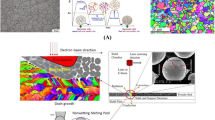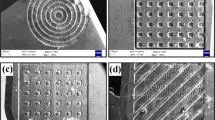Abstract
Machined surface with ultrafine grained microstructure can be obtained through severe plastic deformation in high-speed machining (HSM) process. The aim of this paper is to investigate the evolution of grain size and micro-hardness during HSM of Ti-6Al-4V alloy using the finite element method (FEM) and user subroutine VUSDFLD of Abaqus/Explicit. Firstly, a FE model to simulate the cutting process of Ti-6Al-4V is proposed. The proposed cutting simulation model is verified by high-speed machining experiments in terms of cutting force and chip morphology. Secondly, a novel user subroutine VUSDFLD based on equations of Zener-Hollomon and Hall-Petch is developed to simulate the modifications of grain size and micro-hardness in chip formation and machined surface generation under different cutting speeds. Parameters in the equations of Zener-Hollomon and Hall-Petch are modified for Ti-6Al-4V for simulation of the change of grain size and micro-hardness during HSM. Lastly, the simulation results of the microstructure evolution in chips and machined surfaces are compared with experimental results obtained by optical microscopy, scanning electron microscopy (SEM), and measurement of micro-hardness. The comparison results show that the evolution of grain size and micro-hardness of Ti-6Al-4V in HSM can be accurately predicted by the modified Zener-Hollomon and Hall-Petch equations. This research indicates that smaller grain sizes are produced into both chips and machined surfaces due to more severe deformations with increasing of the cutting speed. The findings validate that HSM is a reliable approach to generate refined grains if proper machining parameters are selected. HSM can also be applied as a novel material test method to study the relationship between microstructure evolution and deformation parameters.
Similar content being viewed by others
References
Deng WJ, Xia W, Li C, Tang Y (2009) Formation of ultra-fine grained materials by machining and the characteristics of the deformation fields. J Mater Process Technol 209:4521–4526
Umbrello D (2013) Investigation of surface integrity in dry machining of Inconel 718. Int J Adv Manuf Technol 69:2183–2190
Gupta RK, Raman RKS, Koch CC (2010) Fabrication and oxidation resistance of nanocrystalline Fe10Cr alloy. J Mater Sci 45:4884–4888
Hoog CO, Birbilis N, Estrin Y (2008) Corrosion of pure Mg as a function of grain size and processing route. Adv Eng Mater 10:579–582
Tao NR, Tong WP, Wang ZB, Wang W, Sui ML, Lu J, Lu K (2003) Mechanical and wear properties of nanostructured surface layer in iron induced by surface mechanical attrition treatment. J Mater Sci Technol 19:563–566
Wan ZP, Zhu YE, Liu HW, Tang Y (2012) Microstructure evolution of adiabatic shear bands and mechanisms of saw-tooth chip formation in machining Ti-6Al-4V. Mater Sci Eng A 531:155–163
Swaminathan S, Shankar MR, Rao BC, Compton WD, Chandrasekar S, King AH, Trumble KP (2007) Severe plastic deformation (SPD) and nanostructured materials by machining. J Mater Sci 42:1529–1541
Shekhar S, Abolghasem S, Basu S, Cai J, Shankar MR (2012) Effect of severe plastic deformation in machining elucidated via rate-strain-microstructure mappings. ASME J Manuf Sci Eng 134:0310081–03100811
Calistes R, Swaminathan S, Murthy TG, Huang C, Saldana C, Shankar MR, Chandrasekar S (2009) Controlling gradation of surface strains and nanostructuring by large-strain machining. Scr Mater 60:17–20
Prete AD, Filiceb L, Umbrello D (2013) Numerical simulation of machining nickel-based alloys. CIRP Ann Manuf Technol 8:540–545
Ding HT, Shen N, Shin YC (2011) Dislocation density-based grain refinement modeling of orthogonal cutting of titanium. Comput Mater Sci 50:3016–3025
Melkote S, Liu R, Fernandez P, Marusich T (2015) A physically based constitutive model for simulation of segmented chip formation in orthogonal cutting of commercially pure titanium. CIRP Ann Manuf Technol 1327:1–4
Bariani PF, Negro TD, Bruschi S (2004) Testing and modelling of material response to deformation in bulk metal forming. CIRP Ann Manuf Technol 53:573–596
Quan GZ, Luo GC, Liang JT, Wu DS, Mao A, Liu Q (2015) Modelling for the dynamic recrystallization evolution of Ti-6Al-4V alloy in two-phase temperature range and a wide strain rate range. Comput Mater Sci 97:136–147
Caruso S, Renzo SD, Umbrello D, Jayal AD, Dillon OW, Jawahir IS (2011) Finite element modeling of microstructural changes in hard turning. Adv Mater Res 223:960–968
Rotella G Jr, Dillon OW, Umbrellob D, Settineri L, Jawahir IS (2013) Finite element modeling of microstructural changes in turning of AA7075-T651 alloy. J Manuf Process 15:87–95
Hughes GD, Smith SD, Pande CS, Johnson HR, Armstrong RW (1986) Hall-Petch strenghening for the microhardness of twelve nanometer grain diameter electrodeposited nickel. Scr Metall 20:93–97
Rotella G, Umbrello D (2014) Finite element modeling of microstructural changes in dry and cryogenic cutting of Ti6Al4V alloy. CIRP Ann Manuf Technol 63:1–4
Arisoy YM, Özel T (2015) Prediction of machining induced microstructure in Ti-6Al-4V alloy using 3-D FE-based simulations: effects of tool micro-geometry, coating and cutting conditions. J Mater Process Technol 220:1–26
Özel T, Arisoy YM (2014) Experimental and numerical investigations on machining induced surface integrity in Inconel-100 nickel-base alloy. CIRP Ann Manuf Technol 13:302–307
Chen G, Ren CZ, Yang XY, Jin XM, Guo T (2011) Finite element simulation of high-speed machining of titanium alloy (Ti-6Al-4V) based on ductile failure model. Int J Adv Manuf Technol 56:1027–1038
Momeni A, Abbasi SM (2010) Effect of hot working on flow behavior of Ti-6Al-4V alloy in single phase and two phase regions. Mater Des 31:3599–3604
Abbasi SM, Momeni A (2011) Effect of hot working and post-deformation heat treatment on microstructure and tensile properties of Ti-6Al-4V alloy. Trans Nonferrous Metals Soc China 21:1728–1734
Johnson GR, Cook WH (1983) A constitutive model and data for metals subjected to large strains, high strain rates and high temperatures. Proceedings of the Seventh International Symposium on Ballistics. Hague, Netherlands, In, pp 541–547
Lee WS, Lin CF (1998) High-temperature deformation behavior of Ti-6Al-4V alloy evaluated by high strain-rate compression tests. J Mater Process Technol 75:127–136
Abaqus Inc. Analysis user’s manual. Version 12.1 USA.
Sun J, Guo YB (2009) Material flow stress and failure in multiscale machining titanium alloy Ti-6Al-4V. Int J Adv Manuf Technol 41:651–659
Ambati R, Huang Y (2011) FEM mesh-dependence in cutting process simulations. Int J Adv Manuf Technol 53:313–323
Calamaz M, Coupard D, Girot F (2008) A new material model for 2D numerical simulation of serrated chip formation when machining titanium alloy Ti-6Al-4V. Int J Mach Tools Manuf 48:275–288
Ding R, Guo ZX (2004) Miscrostructural evolution of a Ti-6Al-4V alloy during β-phase processing: experimental and simulative investigations. Mater Sci Eng A 365:172–179
Author information
Authors and Affiliations
Corresponding author
Rights and permissions
About this article
Cite this article
Wang, Q., Liu, Z., Wang, B. et al. Evolutions of grain size and micro-hardness during chip formation and machined surface generation for Ti-6Al-4V in high-speed machining. Int J Adv Manuf Technol 82, 1725–1736 (2016). https://doi.org/10.1007/s00170-015-7508-1
Received:
Accepted:
Published:
Issue Date:
DOI: https://doi.org/10.1007/s00170-015-7508-1




